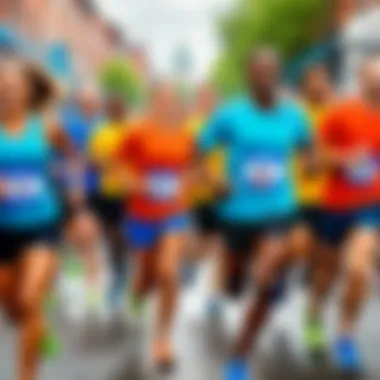Insights from 'Born to Run': Human Endurance Explored


Intro
Christopher McDougall’s book Born to Run opens up a world where the primal joy of running intertwines with captivating stories, insights into the human body, and the wisdom of ancient cultures. It’s not just about putting one foot in front of the other; rather, it’s an exploration of the depths of human potential. McDougall poses the question that many enthusiasts ponder: What if modern humans are not only wired to run but do so in a way that is more beneficial for our health and well-being?
As we delve into the various themes woven throughout this text, we will touch on how running connects to our cultural identity, the evolution of the sport, and the often-overlooked influence of indigenous practices. This examination reveals a contrasting narrative to contemporary views on physical activity that tend to overemphasize technology and modern conveniences. McDougall aims to encourage readers to embrace a more simplified, natural approach to running, one that challenges the status quo of sports and fitness. In the ensuing sections, we will dissect these themes, each illuminating a facet of human endurance and evolution.
Theme Exploration
The book isn't just a narrative about endurance running; it's a deep dive into numerous themes that speak to our intrinsic relationship with the activity. From health benefits to footwear debates, readers will find a rich tapestry of ideas linked to our evolutionary past and its relevance to contemporary life. By analyzing indigenous cultures and their running traditions, McDougall underscores the importance of understanding how we can harness our innate capabilities.
This thorough exploration will serve as a foundation in understanding not only our physical form but the cultural significance that running has held throughout history.
For the discerning reader, Born to Run offers an opportunity to re-evaluate what it means to be human in the context of endurance. It goes beyond the surface-level appreciation of sport and provides a platform for reflection on how we navigate this act, which has been integral to our survival for millennia.
Prologue to 'Born to Run'
The journey into the depths of Christopher McDougall's 'Born to Run' is not merely about the act of running; it's an exploration of endurance that stretches back to the very roots of human evolution. This book interweaves science, culture, and personal experience in a compelling narrative that speaks to both seasoned athletes and casual readers alike. McDougall wades into the profound relationship between humans and running, challenging conventional beliefs while illuminating the art of moving through space with purpose and vigor.
Each chapter navigates through historical contexts, physiological insights, and cultural practices that shape the world of running today. By focusing on the synthesis of these elements, readers can gain a robust understanding of how endurance activities not only enhance physical health but also reinforce social ties and cultural identities. The exploration of running stretches beyond the surface; it touches on our innate instincts, communal bonds, and even the mindfulness that accompanies movement. Through 'Born to Run', McDougall poses essential questions about our lifestyle choices and the tools we utilize - including the controversial impact of modern footwear.
The importance of diving into McDougall’s narrative lies in broadening our comprehension of running as a fundamental component of human existence. This introduction serves as a vital precursor to the finer details to be dissected in subsequent sections, setting the stage for an insightful journey into the myriad of ways that running reflects our evolutionary past and feeds into our present experiences and future aspirations.
Overview of McDougall's Journey
Christopher McDougall embarked on a quest that took him deep into the canyons of Mexico, where he engaged with the Tarahumara tribe—known for their remarkable distance-running abilities. This journey was not just geographical; it was, in essence, a personal search for understanding and healing. Frustrated with persistent injuries and influenced by the increasing distance he encountered in marathons, McDougall aimed to uncover the secrets to why some people could run for days without weariness. His dive into the Tarahumara culture sparked insights that would reform his views on what it means to run. This was more than just a sporting endeavor; it crowded into the explorations of ancient wisdom and the primal instincts buried within us.
Thesis Statement
This article seeks to unravel the multifaceted themes presented in 'Born to Run' through the lens of human endurance and evolution. By analyzing McDougall's experiences, the physiological reactions to running, cultural implications from indigenous practices, and the repercussions of contemporary footwear design, we aim to challenge and enlighten the reader's comprehension about running's role in health and society. With this narrative, we strive to highlight both the science and the emotive connection to movement that prevails, framing running not only as a sport but as a vital expression of being human.
The Science of Running
The realm of running is not just a physical endeavor; it’s a complex interplay of biomechanics, physiology, and psychology. The significance of The Science of Running in Christopher McDougall's work cannot be overstated, as it sheds light on how our bodies are designed for endurance. McDougall explores not merely the act of running but also what it reveals about human evolution and our innate capabilities. Analyzing how we move helps delineate the boundaries of performance and the potential for improvement.
One cannot ignore the interconnectedness of various elements that contribute to successful running. A thorough understanding of the physiological mechanisms at play can transform a casual jogger into a more efficient runner. Let’s delve into two pivotal aspects of running: the physiology of long-distance running and the energy systems utilized during this sport.
Physiology of Long-Distance Running
When contemplating long-distance running, one must first familiarize with how the human body optimally adapts to the taxing demands of extended physical activity. At its core, the physiology of long-distance running involves a few key components:
- Cardiovascular Endurance: The heart and lungs must work in concert to supply oxygen-rich blood to the muscles. This involves a robust cardiovascular setup that can handle prolonged exertion.
- Muscle Fiber Types: Different muscle fibers play various roles in running. While fast-twitch fibers are crucial for sprinting, slow-twitch fibers dominate in long-distance activities due to their resistance to fatigue.
- Biomechanics: The way an individual moves—posture, gait, and stride patterns—affects performance and injury risk. This aspect often gets little attention but is crucial for longevity in the sport.
Understanding these physiological elements allows runners to fine-tune their training regimens. McDougall argues that such knowledge not only amplifies performance but shapes how one relates to their body while running.
Energy Systems Utilized in Running
Energy, like the lifeblood of running itself, comes from several distinct systems, and understanding them is vital for any serious runner. There are three primary energy systems:
- ATP-PC System: This is the quickest source of energy, utilized for very short activities, typically lasting 10 seconds or less.
- Anaerobic Glycolysis: This system kicks in for moderate lengths of time, producing energy without the need for oxygen and lasting up to two minutes during high-intensity efforts.
- Aerobic System: This takes over for prolonged activities and, crucially, leverages oxygen. It powers long-distance running, allowing the body to utilize fat and glycogen reserves for fuel.
Runners often unknowingly switch between these systems based on the intensity and duration of their efforts. McDougall’s exploration of running keeps a keen focus on this aspect of energy management, and understanding it can lead to smarter training choices.
Even the most natural runner must acknowledge the science behind their stride.
Each runner will experience unique demands on their body depending on a multitude of factors, including age, fitness levels, and even psychological elements. Thus, a solid foundation in the science of running isn’t merely an academic exercise; it’s imperative for anyone keen on improving their performance, enhancing their enjoyment, or simply understanding their own body better.
In summary, The Science of Running interlaces anatomy and evolution beautifully. McDougall’s insights push for a deeper understanding of our physical selves while beckoning runners to appreciate the intricate workings behind each mile. By knowing ourselves, we can run further, stronger, and hopefully with more enjoyment.
Cultural Insights


Cultural insights serve as the backbone in understanding the narrative woven through Christopher McDougall's engaging work. The unique perspectives from various indigenous groups, alongside modern societal practices, paint a vivid picture of the art and significance embedded in running. These cultural elements not only showcase running as a physical exercise but also highlight its deeper connotations as a ritual, tradition, and mode of communication among communities.
By exploring the cultural significance, we discover the ways running transcends mere competition. It becomes a means of storytelling, carrying the history and lessons of a civilization. In essence, it emphasizes how intertwined human experiences are with the art of running, demonstrating that every step on the track is a reflection of the values, challenges, and victories faced by a community.
The Tarahumara Tribe
The Tarahumara people of Mexico, known for their astonishing long-distance running abilities, epitomize the profound connection between culture and running. These individuals have been running through the rugged terrain of the Sierra Madre for centuries, often covering extraordinary distances barefoot or in simple footwear, like sandals made from recycled tires.
Their approach to running is not driven by the desire to win races or achieve personal bests—it's deeply embedded in their way of life. Races known as "ultramarathons" are not just competitions but communal events filled with music, dance, and a strong sense of camaraderie. This reflects a philosophy that honors endurance and resilience as a collective endeavor, fostering community spirit above individual accolades. The Tarahumara believe that their running connects them spiritually to their ancestors and the land they inhabit, making every stride both a tribute and a celebration.
*"For the Tarahumara, running is a way of life, a path towards enlightenment, and a method for expressing their culture to the world."
Running as a Cultural Practice
Running stretches far beyond the physical realm for many cultures; it serves as a rite of passage, a means to forge identities, and a method to share stories. In regions across the globe, rituals surrounding running reflect the communal values and individual perseverance within societies.
In places like Japan, the practice of “Ekiden”, which involves relay races over long distances, brings people together, nurturing teamwork and cultural pride. This not only keeps the spirit of competition alive but strengthens social bonds, allowing participants to feel part of something greater than themselves.
Similarly, in the United States, events like marathons or fun runs often raise awareness and funds for various causes. This blending of sport with social consciousness illustrates how running is leveraged as a platform for community engagement and cultural dialogue. It's a unifying force that resonates with the ethos of contributing to the greater good.
In summary, the exploration of cultural insights in "Born to Run" not only enriches our understanding of running's significance across different societies but also encourages a deeper appreciation of how these diverse practices shape lives and communities. Running is a shared human experience, emphasizing resilience, connection, and the collective human spirit.
Historical Context of Endurance Running
The journey of understanding human endurance isn't simply a matter of anatomy or physiology; it’s woven into the very fabric of our history. When we dive into this topic, we're not only pulling apart the layers of muscle and bone but also examining our evolutionary background, societal rituals, and cultural practices that have shaped running as we know it today. The historical context surrounding endurance running provides a rich tapestry that illustrates how this primal activity has evolved over millennia, affecting our health, our culture, and even our identity.
Running has been more than just a method of transport; it has played roles in hunting, communication, and even spirituality. This multifaceted significance underlines why McDougall chose to center his discussions in Born to Run around ancient methodologies and practices. By understanding where we come from, we can better appreciate our path forward.
Evolutionary Perspective
To appreciate the endurance running of today, one must first look back to our hominid ancestors. The body’s architecture—the long legs, the upright posture—has been fundamentally designed for distance running. Researchers suggest that early humans derived significant evolutionary advantages from their ability to run long distances. The ability to persistently chase prey or outrun threats was undoubtedly a game changer.
Consider this: some anthropologists argue that running helped early humans in hunting techniques known as persistence hunting. This involves chasing down animals over extended distances until they succumbed to exhaustion. The caloric expenditure was balanced by the protein gain, illustrating the survival advantage of endurance.
- Key points about the evolutionary perspective:
- Adaptations in the skeletal system that promote endurance.
- The role of sweating and thermoregulation in long-distance efforts.
- Social cohesion in groups fostering more complex running strategies.
The notion that we were born to run is not just a catchy phrase; it’s apprehensible proof of our long-classified history. As McDougall highlights, our connection to running goes beyond mere genetics; it’s interwoven with how we adapted to our environments and survived as a species.
Ancient Civilizations and Running
Fast forward from our early ancestors to the civilizations that laid down the foundations for cultures around the globe. Ancient Egyptians, Greeks, and Native American tribes, among others, featured running prominently in their celebrations, athletic events, and even religious ceremonies. The Olympic Games, which began around 776 BC, included running events that were not just about competition but about honoring the gods and engaging with the community.
In Mexico, the Tarahumara tribe continues to use running both as a cultural practice and a means to connect with their ancestors. McDougall’s encounters with these extraordinary runners reveal how other cultures view running as part of their identity and adaptation to the land. It didn’t commence as an isolated exercise but as a communal activity that bonded tribes and communities.
- Elements of running in ancient civilizations:
- Races were often linked to spiritual beliefs and community gatherings.
- Symbolized strength, vitality, and the blessings of the gods.
- Fostered citizen participation and camaraderie among various communities.
"Running is a communication. It connects us: to the earth, to each other, and to our past. In each stride, we echo the footsteps of our ancestors who ran before us."
Understanding the historical context of endurance running highlights its significance. It's not merely a pastime or a workout but a story of survival, connection, and cultural identities that persist to this day. This legacy echoes in McDougall's work, offering profound insights on how running can reshape our understanding of human capability in the modern world.
Impact of Modern Footwear
The discussion around modern footwear grabs attention for a multitude of reasons, particularly in the context of endurance running. In Christopher McDougall's narrative, the evolution of running shoes is portrayed as both an innovation and a potential hindrance. As running has transitioned from a natural instinct intertwined with human life to a sport equipped with advanced technology, the role of footwear raises vital questions about performance, safety, and health.
Many believe that contemporary running shoes, often packed with cushioning and support, provide runners with an edge. However, McDougall argues that they can also create a false sense of security, leading to poor running habits. The excess cushioning may actually inhibit natural gait and mechanics, resulting in injuries that could be avoided by a more minimalist approach. The way shoes have evolved reflects a significant shift in our understanding of running biology, yet it seems there's still a lot to learn from the past.


Analysis of Running Shoes
When we dive into the analysis of running shoes, it's noteworthy how technology has advanced in this area. Shoes are now engineered with various features to enhance performance and comfort. However, this abundance of features raises pertinent considerations:
- Cushioning Technology: Many shoes today utilize materials like EVA foam and gel inserts to soften impact. This can be beneficial during long runs, yet overreliance on cushioning might dull proprioceptive feedback that runners naturally gain from their feet.
- Stability vs. Motion Control: Brands often push for "stability" shoes to correct overpronation. The concept is appealing, but the effectiveness of these corrections can sometimes mislead individuals into thinking their mechanics are flaw-free when they may be compensating in other ways.
- Weight and Design: Lighter shoes have become a trend, aimed at improving speed. However, less sturdy options may expose runners to risks of injury, especially on uneven terrains.
A growing concern surrounds the balance of innovation and instinct. While the science of running shoes has vastly improved, it challenges how we think about an age-old practice. In McDougall’s work, the argument leans towards embracing a more elemental approach, hinting at the wisdom of barefoot running, supported by cultural practices like those of the Tarahumara people.
Minimalist Running Movement
The minimalist running movement rises as a response to the complexities created by modern footwear. It advocates for a return to simpler designs, promoting the idea that runners should connect more deeply with the ground beneath them. This paradigm shift implies a focus on natural biomechanics, which often resonates with the stories shared in "Born to Run."
Key ideas that characterize this movement include:
- Simplicity in Design: Minimalist shoes tend to have less structure, featuring a lower drop, thinner soles, and lighter materials. This encourages a forefoot-strike running style, aligning with the natural adaptations of feet developed through millennia.
- Enhanced Body Awareness: Proponents argue that running in minimal footwear fosters an acute awareness of one's mechanics, likely leading to better running form over time. This heightened sensitivity can reduce the risk of injury because as one becomes more attuned to their body’s signals and movements, one can adjust accordingly.
- Connection to Nature: Many advocates also speak to the meditative quality of running in minimalist shoes—an experience that can evoke a sense of freedom and communion with nature that some high-tech gear fails to replicate.
Ultimately, as modern runners navigate the complexities of footwear choices, McDougall’s insights serve as a crucial reference point. Embracing our inherent capabilities while thoughtfully considering how technology influences our experience is certainly a path worth pursuing. It's not just about competition; it’s also a journey towards understanding the deeper connections we have with running.
"Our feet, like the Tarahumara runners, are capable of remarkable feats if we allow them the freedom to do what they do best."
The journey of modern running footwear illustrates more than just a trend; it expresses a fundamental tension between enlightenment and comfort. Whether one chooses high-tech options or minimalist styles, an awareness of how these choices affect running habits remains paramount.
Health Benefits of Running
The exploration of running’s health benefits takes center stage in the discourse surrounding Christopher McDougall's Born to Run. Understanding how running transforms both the body and mind isn't merely an academic pursuit; it's a fundamental aspect of human experience. As one dives into the pages of McDougall's work, the idea becomes evident that this primal activity holds transformative potential not only for elite athletes but for anyone willing to lace up their shoes.
Physical Health Advantages
Physical health takes precedence in understanding the role of running in daily life. It is not just about hitting the pavement for the sake of fitness; it encompasses a spectrum of benefits reflected in scientific research and anecdotal evidence.
- Weight Management: Regular running promotes calorie burning, making it easier to maintain a healthy weight. The heart pumps faster, the lungs expand, and energy is expended. This simple activity has been shown to increase metabolism, which can aid those looking to shed some unwanted pounds.
- Cardiovascular Strength: Running acts as a robust cardiovascular workout. The consistent rhythm of running engages the heart and strengthens blood vessels. One could think of it as a tune-up for your circulatory system, making it more efficient over time.
- Improved Muscular Strength: Engaging different muscles during a run builds strength as well as endurance. The legs, core, and even the arms see benefits as they work in unison.
- Bone Density: High-impact exercises like running can lead to stronger bones. This is particularly important as the body ages. A solid runner often maintains better bone density compared to sedentary lifestyles. As the saying goes, "A good run beats a pill any day."
- Enhanced Immune Function: Regular aerobic activity, such as running, helps bolster the immune system. A study on long-distance runners found they often experienced fewer infections compared to those who lead more sedentary lives.
Mental Health Improvements
Running is not only a physical endeavor but a mental one as well. The interplay between body and mind during a run can yield profound psychological benefits.
- Stress Relief: Just as a hammer and nail meet to create structure, so does the rhythmic nature of running help to hammer away life's stresses. The endorphins released during running can cultivate a mood boost, often referred to as the “runner's high.”
- Cognitive Clarity: Running encourages the production of brain-derived neurotrophic factor (BDNF), a protein vital for memory and learning. Many runners have discovered that a jog can clear the cobwebs from their thoughts, empowering them to tackle challenges with renewed vigor.
- Enhanced Sleep Quality: Engaging in the rhythmic activity of running can lead to deeper and more restorative sleep cycles. Sleep is essential for recovery, and without it, even the most determined runner might find themselves at a standstill.
- Building Community: Connecting with others through running—whether in organized groups or informal meet-ups—creates a sense of belonging. The shared experience can act as a balm, fostering social connections that alleviate feelings of loneliness.
"Running can be a solitary endeavor, but it's also a gateway to friendships that fuel the spirit."
In essence, the advantages brought about by running are multi-faceted. McDougall's exploration of these health benefits propels the narrative, emphasizing the essential connection between this ancient practice and contemporary wellness. Therefore, whether considering physical or mental health, the message remains clear: running is more than just exercise; it is a pathway to a more integrated and vibrant existence.
Running in the Modern Era
The modern landscape of running has transformed significantly, intertwining tradition with innovation. In this section, we explore the unique challenges that urban runners face and the rich community and social dimensions that come with running today. These aspects not only affect how individuals pursue running but also reflect broader societal changes.
Challenges Faced by Urban Runners
Urban environments present a mixed bag for runners, creating both opportunities and obstacles. Unlike the open trails of the countryside, cityscapes often pose unique challenges:
- Traffic and Pollution: Runners frequently navigate busy streets, contending with the ever-present sound of honking cars and exhaust fumes. Urban pollution can hamper performance and raise health concerns.
- Limited Space: Parks are scarce in some urban quarters, forcing runners to share trails with cyclists, pedestrians, and even pets. This can make runs feel cramped and less enjoyable.
- Safety Concerns: Many urban areas face issues with crime, making it essential for runners to be cautious about where and when they hit the pavement. The need for vigilance can detract from the running experience.
- Weather Conditions: Urban areas tend to have a heat island effect, leading to higher temperatures in the summer and longer-lasting pavement heat, which can affect both training and recovery.
Nonetheless, urban running isn't all gloom and doom. There are tremendous benefits in embracing running despite these hurdles. A sense of resilience develops among urban runners; they adapt, often finding creative solutions to circumvent obstacles. The act of running can cut through the noise of city life, offering clarity and peace.
Community and Social Aspects of Running
Running has evolved into a vibrant community activity in the modern era, transcending its traditional image of a solitary sport. People from all walks of life come together, forming bonds that extend beyond the miles run. Some key elements of this social fabric include:
- Running Clubs and Groups: Joining local running groups such as the Black Girls Run! or the November Project fosters a sense of belonging. Runners motivate one another, encouraging accountability and shared success.
- Events and Competitions: Races, marathons, and charity runs have become social spectacles. They provide an opportunity not only to challenge personal limits but also to socialize and support various causes, amplifying a community spirit.
- Online Communities: With platforms like Reddit and Facebook, runners can share experiences, advice, and humor with peers from around the globe. These interactions create a rich tapestry of support and camaraderie.
- Inclusivity and Diversity: The modern running movement places a strong emphasis on inclusivity. Initiatives aimed at underrepresented groups are blossoming, welcoming everyone from workout novices to experienced athletes.


"Running becomes more than just a sport; it is a way to connect, share, and thrive together in a fast-paced world."
In essence, despite the challenges that urban runners face, they often find solace and inspiration in the camaraderie of their communities. This duality of struggle and connection is a unique element of modern running culture, making the entire experience richer and more rewarding.
Personal Narratives and Experiences
The threads of personal narratives woven throughout Born to Run underscore a fundamental aspect of the human experience: the stories of those who run. Such narratives are not merely embellishments but serve various critical functions, enlightening our understanding of endurance, motivation, and cultural identity. In the landscape of running, where physical capacity meets mental fortitude, personal stories create a richer tapestry, illustrating how individuals transcend their limits.
Personal experiences in running resonate deeply, offering insights into struggle and triumph. Each runner's journey is unique, yet they share common rhythms of doubt, perseverance, and ultimately, achievement. Recognizing the varied reasons individuals lace up their shoes—from running for health benefits to seeking solace or community—highlights the complexity and richness of the sport.
Moreover, these stories propel others into action. When someone reads about a fellow runner overcoming immense odds, it can ignite a spark of inspiration. This interconnectedness of experience helps unify the running community, reinforcing that the journey of each runner, irrespective of their background, contributes to a larger narrative of resilience and dedication.
"The stories of runners form the heartbeat of the sport, reminding us that every step is a piece of a bigger story."
Inspirational Stories from Runners
Many runners have stories that not only motivate others but also serve as testimonials to the transformative power of running. One poignant tale is of a woman, who, after experiencing a life-altering injury, found herself at a crossroads. Doctors had advised against high-impact activities, but the allure of running persisted. Slowly, she embraced the challenge, adapting her approach—trading conventional running for softer surfaces and focusing on mindful practices. Her journey from doubt to finish lines became a beacon for others in similar circumstances, illustrating that tenacity can redefine one's limits.
In addition to individual narratives, group endeavors can also illustrate community spirit. For instance, stories emerging from local running clubs often shed light on friendships formed through shared struggles and triumphs. One such club in San Francisco organized a marathon training program specifically for newcomers. As they shared their experiences and supported one another, the bonds strengthened—not just as athletes but as humans navigating life’s hurdles together. Collectively, these accounts highlight that running is as much about the personal journey as it is about communal support and understanding.
McDougall's Own Running Journey
Christopher McDougall’s insights are steeped in his personal journey as both a runner and a writer. His struggles with injuries led him to seek an alternate understanding of running, one that was less about performance metrics and more about enjoyment and connection to the experience. This reflection anchored his exploration in Born to Run, showcasing how his belief in natural movement transformed his perspective on human endurance.
In his pursuit to understand the underlying essence of human running, McDougall’s own challenges spilled into rich storytelling. The anecdotes about his attempts to connect with the Tarahumara tribe brought depth to his narrative, illustrating not only the physical aspects of running but also the cultural richness and communal values attached to the sport. His journey, fraught with vulnerabilities, unfolds as a narrative of curiosity.
Ultimately, McDougall's own path through the world of running serves as an apt reminder that the journey is often filled with bumps, but within those bumps lies the essence of what makes any physical endeavor worthwhile. Engaging with running through a lens of discovery enriches our understanding of what it means to be human, and these stories add invaluable layers to the shared tapestry of the running culture.
Critical Reception of 'Born to Run'
The reception of Christopher McDougall's work Born to Run transcended mere book reviews; it sparked a dialogue around the very nature of endurance, running practices, and health philosophies as they relate to modernity. Understanding its critical reception is paramount not just in grasping how it influenced fitness culture, but also in examining its potential implications for physiological studies. Critics and enthusiasts have dissected the book from various angles, noting its profound impact on both running communities and broader discussions on human capability.
Positive Reviews and Endorsements
Among the vast sea of opinions, many reviews echoed a similar sentiment: Born to Run is an inspiring exploration that melds well-researched facts with a narrative that feels more like an adventure story than a health guide.
- Endorsement by Athletes: Renowned long-distance runners, such as Scott Jurek and Dean Karnazes, have lauded McDougall's work, equating it to a vital text for those serious about endurance sports. Their endorsements lend credibility to McDougall's arguments, emphasizing the potential benefits of a more natural running style.
- Appeal to a Broader Audience: The book also received positive nods from mainstream book reviewers, who highlighted McDougall's ability to make complex scientific theories accessible. For those not steeped in the science of running, McDougall's storytelling and compelling characters make the text relatable and engaging.
- Cultural Relevance: Reviewers point out how Born to Run taps into contemporary societal themes, like the embrace of minimalism in lifestyle and fitness. This cultural relevance provides an additional layer of importance to the work, as it resonates with a growing audience seeking not just physical fitness but a holistic approach to well-being.
In a nutshell, the positive reviews position Born to Run not just as a book about running but also as a catalyst for conversations around human potential.
Criticism and Controversies
Despite its accolades, Born to Run was not without its detractors. The critical reception unearthed a host of controversies that provide a more nuanced understanding of the text. Some notable critiques include:
- Scientific Rigor: Critics have pointed out that while the narrative is engaging, some of the scientific aspects might lack depth. Not all scientists agree with McDougall's conclusions regarding minimalist running shoes or the biomechanics of long-distance running. They argue that the book oversimplifies complex physiological responses to running.
- Idealization of Indigenous Cultures: McDougall’s portrayal of the Tarahumara tribe has faced scrutiny for romanticizing their running culture. Critics have argued that while he highlights their endurance, he glosses over the underlying societal pressures and challenges these indigenous peoples face.
- Commercialization of Minimalist Running: Some reviewers have raised concerns about how McDougall's narrative may have helped commercialize what is essentially a lifestyle choice pertaining to running gear. The rise of various minimalist shoes and brands has led some to question if they serve the running community or merely boost market trends.
"In the pursuit of understanding human endurance, it is essential not only to celebrate achievements but also to examine the claims that underpin these narratives."
Closure
The conclusion of this article serves as a crucial summation of the profound insights found within Christopher McDougall's Born to Run. By examining the myriad angles from which human endurance, cultural influences, and evolutionary biology converge, we arrive at a richer understanding of running not merely as a sport, but as a foundational aspect of human existence. McDougall invites readers to reconsider the roles of tradition and modernity in our running practices, shedding light on significant implications for both personal health and broader cultural identity.
Summary of Key Findings
In reviewing the key findings articulated throughout the article, several pivotal themes emerge:
- Human Anatomy and Behavior: The text discusses how our unique physiological traits have evolved to support long-distance running, making it an innate capability rather than a mere hobby.
- Cultural Practices: McDougall delves into how indigenous populations like the Tarahumara have maintained running as a vital aspect of their lifestyle. This emphasizes the cultural significance beyond just physical activity.
- Modern Influences: The contrasting impacts of contemporary footwear and training methods raise questions about how technology shapes our natural abilities.
- Health Considerations: The interplay between mental health and physical activity emerges as a reinforcing argument for integrating running into daily routines, benefiting both mind and body.
- Emerging Trends: Trends like the minimalist running movement highlight a shift towards appreciating natural running techniques, paving the way for future generations to reconnect with their roots.
The Future of Running Culture
Looking ahead, the culture surrounding running is poised for transformative changes, influenced by both advancements in gear and shifts in societal attitudes. Here are some considerations for the future:
- Reconnecting with Nature: As urbanization rises, there is a growing desire among runners to escape into natural landscapes, fostering a deeper connection with the environment.
- Technology Integration: With the rise of fitness tracking devices and running apps, technology is expected to play a prominent role in enhancing training regimens and community engagement.
- Inclusive Communities: There's a noticeable trend toward making running more accessible to diverse groups, leading to a broader spectrum of experiences and stories.
- Continual Research: Future studies examining the intersection of running, culture, and technology will further illuminate the complex relationship between our evolutionary past and contemporary practices.
"Running is not just a sport; it is a celebration of human resilience, an echo of our evolutionary journey, and a doorway to individual well-being."
In summary, as we contemplate the future, embracing both the simplicity of running and the nuances of its evolution will redefine the way we perceive this age-old practice. This reflection, rooted in McDougall's compelling narrative, inspires a renewed commitment to running as a fundamental aspect of our existence.







